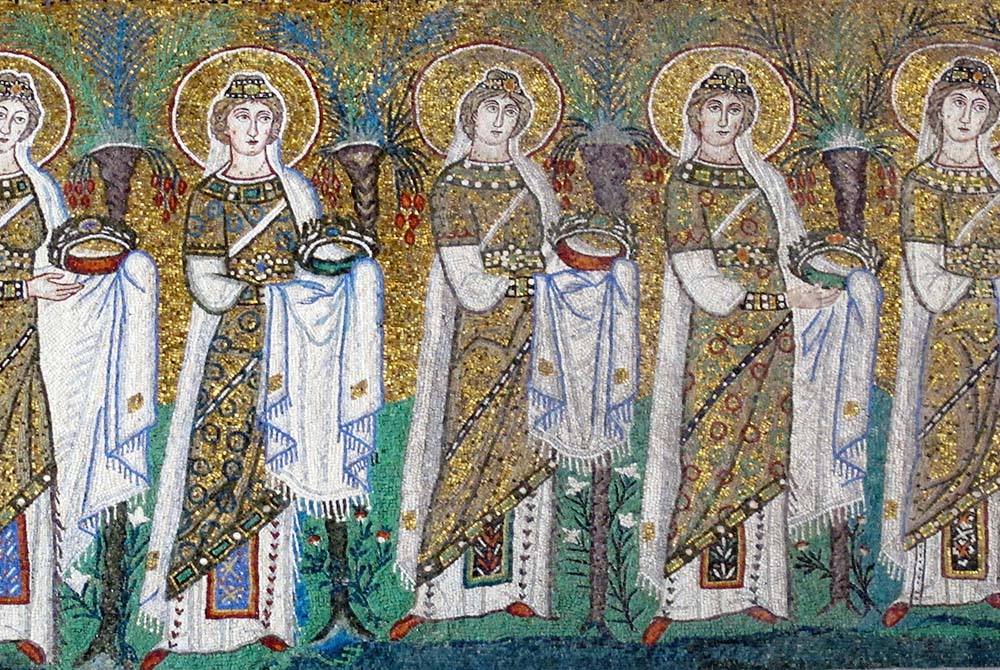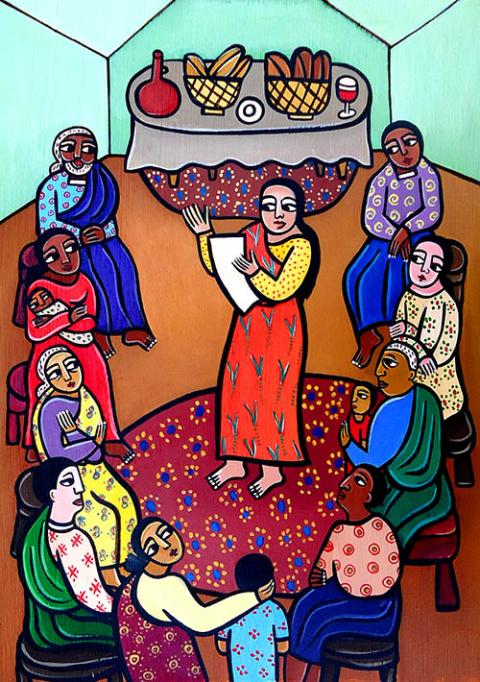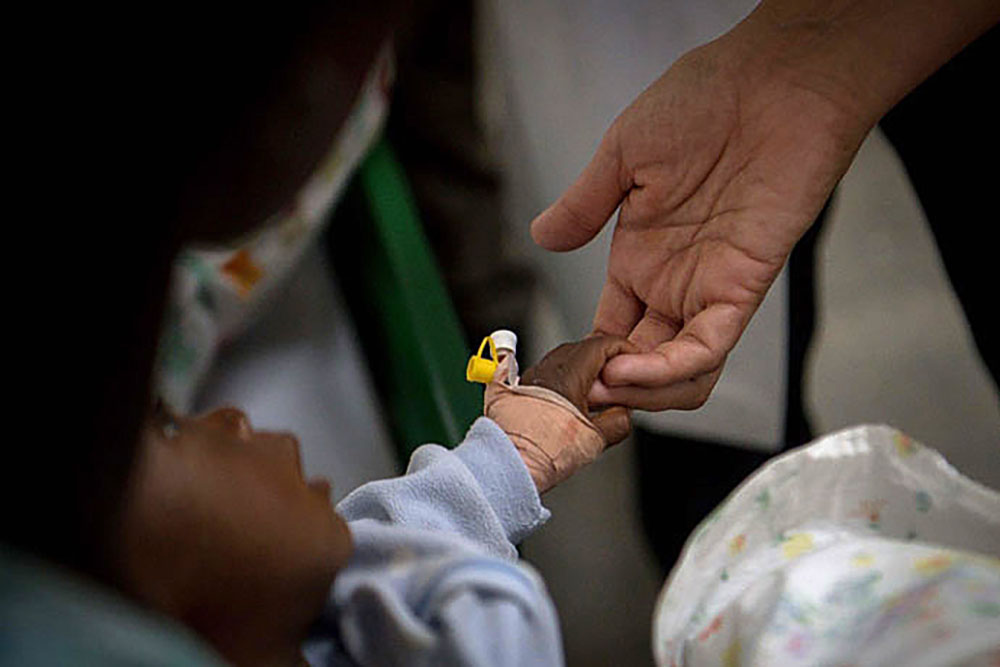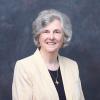
The mosaic of the Holy Virgins, in the sixth-century Church of St. Apollinare Nuovo, Ravenna, Italy (Wikimedia Commons/Sailko)
Editor's note: This series, written by a member of the Pontifical Commission for the Study of the Diaconate of Women, addresses questions related to women religious and the ordained diaconate. This is the first of five essays — the next installment will be published Jan. 21. Join us Friday, Feb. 12, at 2 p.m. Central time, 3 p.m. Eastern, for "Witness & Grace: A Conversation with Phyllis Zagano and Sr. Colleen Gibson" focusing on highlights of this series. Click here to register.
(GSR graphic/Toni-Ann Ortiz; Art by Angelicon/Eri Fragiadaki)
Background: In May 2016, Pope Francis responded to a question posed at the triennial assembly of the International Union of Superiors General (UISG): If women religious are already performing the many ministries of deacons, why not form a commission to study the restoration of women to the diaconate?
The pope responded immediately, naming 12 scholars the following August to the Commission for the Study of the Diaconate of Women who met in Rome four times and returned a report by June 2018. The pope gave a portion of the report to the UISG leadership at their May 2019 assembly. It has not been published.
Then, in October 2019, the same question arose, this time at the Synod of Bishops for the Pan-Amazon Region. If nearly two-thirds of parish groupings are managed by women religious there, why not install women as lectors and acolytes, and share the synod's support of women deacons with the commission?
Again, Francis agreed, saying he would recall the commission, perhaps adding two or three new members. Then, in April 2020, he named an entirely new group to study the question. This second commission has not met, but is expected to begin its work sometime in 2021. It will be the fourth or fifth iteration of commission study of the same topic since the early 1970s. None recommended against women deacons.
While there is no guarantee that Francis will change canon law to allow women to be restored to this ordained ministry, this series of essays seeks to examine the questions most often raised by women religious about the possibility of women religious being ordained as deacons or of women deacons joining religious institutes and orders.
What about ordained women religious?
While discussion about women in the diaconate has historically been truncated, even squashed within the Vatican, the 2016 request of UISG and the 2019 recommendation of the Amazon synod together evidence the genuine need for diaconal ministry by women ordained to such service. The point is not to allow women religious and other women merely to take on more functions. The point is to allow the church to recognize them as women, as religious, and as pastoral ministers and, should they find within themselves the vocation to the diaconate, as ordained clerics.

"Pheobe" by Bronx, New York, artist Laura James. St. Phoebe is recognized as the first woman deacon, although we know little about her life. The first-century saint is honored as the prototype for female deacons just as St. Stephen is the prototype for male deacons. (©Laura James, 2008. Used with permission.)
Of course, the effort has never been about "clericalization." More readily, the effort is to connect the present ministries of religious and secular women to the ministry of the bishop, and thereby secure it clearly as in union with the whole church. The question of restoring women, including women religious, to the ordained diaconate moves beyond the notion of their tasks and duties, beyond the "functions" they would more clearly assume. For women religious, the restoration includes identifying these women ministers as who they are: as religious, surely, and also as deacons if they are so called.
Even so, the functions are an important part of the puzzle because, especially in mission territories, women religious are already performing the functions of deacons. But there are other things laypersons cannot do; women ordained as deacons would be able to preach the homily at a given Mass, and would be able to serve as single judge in a canonical proceeding — these just two among other tasks and duties restricted to clerics.
For opponents, the troubling problem with ordained women (religious or secular), it must be clearly stated, is that they would be vested and part of the celebration of the Mass. While the deacon of the Mass proclaims the Gospel, and is able to preach if invited, the deacon of the Mass has other liturgical functions within the sacred celebration.
The deacon's tasks are many. In addition to processing with the celebrating priest, addressing the assembly, proclaiming the Gospel and preaching, the deacon prays the universal prayer and dismisses the congregation at the end of the celebration.
However, most distressing to misogynists is the fact that the deacon ministers the chalice at the altar. That is, the deacon mixes the water and the wine for the sacrifice, fills the chalice, and hands it to the priest. At the showing of the consecrated elements, the deacon elevates the chalice. The deacon also assists with the distribution of Communion, most formally with the administration of the chalice.
While in many territories the fact of women at the altar as temporarily deputed lectors or acolytes is not in the least upsetting to the people of God, pockets of fear are fed by clerics and others for whom the very sight of a woman at the altar is sacrilegious. For a woman to touch the sacred vessels, let alone mix the water and the wine for the sacrifice, is scandalous in their eyes.
Advertisement
Such attitudes reach back into the history of ancient blood taboos, many of which are maintained in closed cultures today. Consider, for example, menstruation huts and the taboos regarding men touching women or of women touching objects.
But the point of ordaining women religious, particularly those who have the care of parishes and parish groupings in many areas of the world, is to enhance, even professionalize, their various ministries. Again, however, the diaconate is not necessary for all women religious, especially and including those who work in mission territories. The diaconate does not replace religious life. The diaconate is necessary for those women religious for whom it is a genuine vocation, distinct from their vocation and identity as religious.
Some 47,000 men, mostly married men, serve as deacons throughout the world, virtually all within diocesan and parish structures, and bishops around the world have warmed to the idea of including women among their ranks. Recall, it was the International Union of Superiors General that asked Francis to consider the ordination of women to the diaconate. Their request included the fact that women religious in many territories were already doing the work of deacons, so, why not ordain them?
The UISG sisters pressed their point in a very specific manner: The fact that they were already performing diaconal ministry potentially underscores their disconnect from the hierarchical church. The sisters who are working in parish structures may be employed by the parish, or their work may be missioner work as part of the charism of their institutes.

An Ursuline sister holds the hand of an infant patient in a cholera clinic in Verrettes, Haiti, in 2017. (CNS/Journey Press/Bryan Woolston)
Generally speaking, the diaconal works of women religious (medical clinics, food banks, educational initiatives) are largely self-funded. Hence, the UISG request strikes to the heart of the diaconal vocation and office in the church. It underscores the need for bishops and parishes to provide for the poor with diocesan resources, not replacing the many organizational works of women religious, but complementing them.
The unsaid question concerns the relationship between the deacon and the bishop. Historically, the deacon served as the diocesan bishop's "right hand," and women deacons functioned in that capacity both literally and figuratively. They anointed ill women as well as female candidates for baptism. At least one woman deacon, Anna, is remembered as the treasurer of Rome.
But as the ordained diaconate of women was increasingly repressed into abbeys and monasteries, its functions became increasingly, if not wholly, ceremonial. So, however, did the functions of male deacons become mostly ceremonial. Even so, within the abbeys and monasteries, women deacons were still needed to minister to ill sisters, in addition to their leading community prayer. Women consecrated as abbesses, often also ordained as deacons, still proclaimed the Gospel and preached to their sisters.
There is no church finding that women cannot be ordained as deacons, only the assumption that Canon 1024 ("Only a baptized male is validly ordained") applies to the diaconate as well as to the priesthood. However, when this law began to be codified, for the most part only men preparing for priesthood were ordained as subdeacons, then as deacons. Church opinion on the matter (Inter Insigniores, 1976, and Ordinatio Sacerdotalis, 1994) solely addresses the question of women priests. Is the church capable of seeing women, both secular and religious women, as bearers of the Gospel and as icons of Christ?







